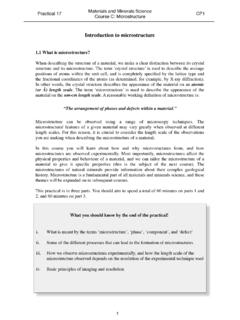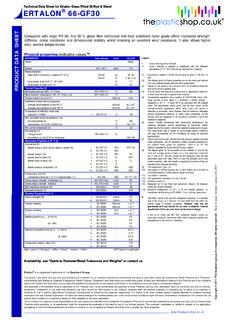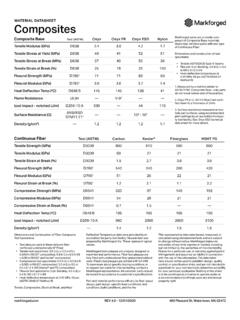Transcription of POLYAMIDE 66 (Nylon 66) - Inference
1 N66 1 Eco-profiles of the European Plastics Industry POLYAMIDE 66 ( nylon 66) A report by I Boustead for PlasticsEurope Data last calculated March 2005 n66 2 PlasticsEurope may be contacted at Ave E van Nieuwenhuyse 4 Box 3 B-1160 Brussels Telephone: 32-2-672-8259 Fax: 32-2-675-3935 IMPORTANT NOTE Before using the data contained in this report, you are strongly recommended to look at the following documents: 1. Methodology This provides information about the analysis technique used and gives advice on the meaning of the results. 2. Data sources This gives information about the number of plants examined, the date when the data were collected and information about up-stream operations. In addition, you can also download data sets for most of the upstream operations used in this report. All of these documents can be found at: n66 3 CONTENTS nylon THE PRODUCTION OF nylon ECO-PROFILE OF nylon n66 4 nylon 66 The polyamides are a group of polymers characterised by a carbon chain with -CO-NH- groups interspersed at regular intervals along it (See Figure 1).
2 They are commonly referred to by the generic name nylon and may be produced by the direct polymerisation of amino-acids or by the reaction of a diamine with a dibasic acid. Different nylons are usually identified by a numbering system which refers to the number of carbon atoms between successive nitrogen atoms in the main chain. Polymers derived from amino-acids are referred to by a single number; for example, nylon -6 is polycaprolactam. Polymers derived from a diamine and a dibasic acid are given two numbers with the first referring to the number of carbon atoms contributed by the diamine and the second referring to the number of carbon atoms supplied by the dibasic acid. Thus nylon 66 is derived from hexamethylene diamine and adipic acid to give the structure shown in Figure 1. CHHC-HHCHHCHHCHHCHH- --- -CHHCHHCHHCHH- ---N-HC-ON-HC-O- Figure 1. Structure of the repeat unit in nylon 66. The research leading to the discovery of polyamides began in 1928 when Carothers began research into polymerisation mechanisms.
3 The work was not aimed at producing any specific polymers but one accidental discovery was the method of producing polyamides, the first, all synthetic polymer ever produced. After perfecting the technique of producing high molecular weights in various polyamides, attention was turned to producing a polymer which could be made into fibres. The polymer that was eventually chosen for commercial development was nylon 66 because of its good balance of properties and the relative ease with which the raw materials could be produced. About two thirds of the nylon produced in Europe is used for fibres (textiles, carpets, etc.) while most of the remainder is used in injection moulded components (automotive parts, consumer goods, etc.) Other smaller uses are films and filaments. nylon 66 is often selected for use because of its combination of toughness, stiffness, high melting point and chemical resistance.
4 It is a relatively easy polymer to modify, so the range of different nylon resins available is wider than for most other polymers. Typical modifiers are flame retardents to reduce flammability, rubber to improve impact resistance and glass or minerals to n66 5 improve stiffness and dimensional stability. Typical uses of the different types of nylon are shown in Table 1. Table 1. Typical uses of nylons Modifier Typical application Unmodified Cable ties Lighter bodies Glass with or without mineral Radiator end tanks Air intake manifolds Covers of various types Mineral reinforced Wheel covers Throttle bodies Toughened Clips Fasteners Ski bindings Flame retarded Switchgear Circuit breakers Other electrical/electronic components THE PRODUCTION OF nylon 66 The principal operations leading to the production of nylon 66 are shown in Figure 2. The essential precursors for nylon 66 are hexamethylene diamine, H2N-(CH2)6-NH2, and adipic acid, HOOC-(CH2)4-COOH.
5 When they are reacted they produce hexamethylene diammonium adipate, commonly referred to as nylon salt, H3N(CH2)6NH3 OOC(CH2)4 COO-. For fibre applications, it is important to ensure that the precursors are reacted in equimolar proportions and that the product is highly purified. The formation, extraction and purification of the salt ensures that these conditions are met. Adipic acid is made by the oxidation of cyclohexane to a mixture of cyclohexanol and cyclohexanone (called KA oil). This mixture is further oxidised with nitric acid to adipic acid. Hexamethylene diamine is made by the reduction of adiponitrile, which is made either by the electronic coupling of acrylonitrile or by the hydrocyanation of butadiene. Adipic acid and hexamethylene diamine are combined in water to make a salt solution. This solution is then passed through a batch or continuous reactor in which the water is removed at high temperature and the nylon polymerises.
6 The polymer is expelled from the reactor and granulated. Higher molecular weights are achieved by solid phase polymerisation. Modified nylons are made by extrusion compounding of the nylon with the modifiers or reinforcements. In some cases, it is possible to compound directly at the reactor without granulating the nylon . n66 6 PropyleneproductionAcrylonitrileproducti onAdiponitrileproductionHexamethylenedia mineproductionNylon 66 saltproductionNylon 66productionAmmoniaproductionBenzeneprod uctionCyclohexaneproductionNitric acidproductionCyclohexanolproductionHydr ogenproductionAdipic acidproductionButadieneproductionNatural gasproductionHexamethylenediamineproduct ionGlass fibreproductionNylon 66 saltproductionSulphuric acidproductionnylon 66 Figure 2 Schematic flow diagram of the principal operations leading to the production of nylon 66. ECO-PROFILE OF nylon 66 Table 2 shows the gross or cumulative energy to produce 1 kg of nylon 66 and Table 3 gives this same data expressed in terms of primary fuels.
7 Table 4 shows the energy data expressed as masses of fuels. Table 5 shows the raw materials requirements and Table 6 shows the demand for water. Table 7 shows the gross air emissions and Table 8 shows the corresponding carbon dioxide equivalents of these air emissions. Table 9 shows the emissions to water. Table 10 shows the solid waste generated and Table 11 gives the solid waste in EU format. n66 7 Table 2 Gross energy required to produce 1 kg of nylon 66. (Totals may not agree because of rounding) Fuel type Fuel prod'n Energy content Energy use Feedstock Total & delivery of delivered in energy energy energy fuel transport (MJ) (MJ) (MJ) (MJ) (MJ) Electricity - Oil fuels Other fuels Totals Table 3 Gross primary fuels required to produce 1 kg of nylon 66. (Totals may not agree because of rounding) Fuel type Fuel prod'n Energy content Fuel use Feedstock Total & delivery of delivered in energy energy energy fuel transport (MJ) (MJ) (MJ) (MJ) (MJ) Coal Oil Gas Hydro - Nuclear - Lignite < < < - < Wood < < < Sulphur < < < Biomass (solid) < < Hydrogen < < - Recovered energy < < - Unspecified < < < - < Peat < < < - < Geothermal < < < - < Solar < < < - < Wave/tidal < < < - < Biomass (liquid/gas) < - Industrial waste < - Municipal Waste < - Wind < - Totals Table 4 Gross primary fuels used to produce 1 kg of nylon 66 expressed as mass.
8 Fuel type Input in mg Crude oil 920000 Gas/condensate 1400000 Coal 640000 Metallurgical coal 240 Lignite 1 Peat 230 Wood 570 n66 8 Table 5 Gross raw materials required to produce 1 kg of nylon 66. Raw material Input in mg Air 1700000 Animal matter <1 Barytes 1 Bauxite 3500 Bentonite 60 Biomass (including water) 39000 Calcium sulphate (CaSO4) 6 Chalk (CaCO3) <1 Clay <1 Cr <1 Cu 1 Dolomite 7 Fe 610 Feldspar <1 Ferromanganese 1 Fluorspar 1 Granite <1 Gravel 2 Hg <1 Limestone (CaCO3) 3200 Mg <1 N2 170000 Ni <1 O2 350 Olivine 6 Pb 3 Phosphate as P2O5 <1 Potassium chloride (KCl) 1 Quartz (SiO2) <1 Rutile 850 S (bonded) <1 S (elemental) 14000 Sand (SiO2) 190 Shale 17 Sodium chloride (NaCl) 29000 Sodium nitrate (NaNO3) <1 Talc <1 Unspecified <1 Zn 25 Table 6 Gross water consumption required for the production of 1 kg of nylon 66. (Totals may not agree because of rounding) Source Use for Use for Totals processing cooling (mg) (mg) (mg) Public supply 121000000 - 121000000 River canal 220000 383000000 383000000 Sea 340000 6200000 6500000 Well 2 43000 43000 Unspecified 45000000 106000000 152000000 Totals 167000000 496000000 663000000 n66 9 Table 7 Gross air emissions associated with the production of 1 kg of nylon 66.
9 (Totals may not agree because of rounding) Emission From From From From From From Totals fuel prod'n fuel use transport process biomass fugitive (mg) (mg) (mg) (mg) (mg) (mg) (mg) dust (PM10) 1400 460 17 230 - - 2100 CO 4400 1000 190 1700 - - 7300 CO2 1600000 4000000 31000 920000 -520 - 6500000 SOX as SO2 7800 9300 270 440 - - 18000 H2S <1 - <1 <1 - - <1 mercaptan <1 <1 <1 <1 - - <1 NOX as NO2 4200 7200 270 1800 - - 14000 NH3 <1 - <1 690 - - 690 Cl2 <1 <1 <1 <1 - - <1 HCl 180 59 <1 20 - - 260 F2 <1 <1 <1 <1 - - <1 HF 7 2 <1 <1 - - 9 hydrocarbons not specified 2000 550 77 1600 - 1 4200 aldehyde (-CHO) <1 - <1 1 - - 1 organics <1 <1 <1 340 - - 340 Pb+compounds as Pb <1 <1 <1 <1 - - <1 Hg+compounds as Hg <1 - <1 <1 - - <1 metals not specified elsewhere 1 5 <1 8 - - 14 H2SO4 <1 - <1 <1 - - <1 N2O <1 7 <1 730 - - 740 H2 200 <1 <1 11 - - 210 dichloroethane (DCE) C2H4Cl2 <1 - <1 <1 - <1 <1 vinyl chloride monomer (VCM) <1 - <1 <1 - <1 <1 CFC/HCFC/HFC not specified <1 - <1 <1 - - <1 organo-chlorine not specified <1 - <1 <1 - - <1 HCN <1 - <1 <1 - - <1 CH4 46000 1100 <1 2200 - <1 49000 aromatic HC not specified elsewhere <1 - 1 27 - 1 29 polycyclic hydrocarbons (PAH)
10 <1 2 <1 <1 - - 2 NMVOC <1 - <1 22 - - 22 CS2 <1 - <1 <1 - - <1 methylene chloride CH2Cl2 <1 - <1 <1 - - <1 Cu+compounds as Cu <1 <1 <1 <1 - - <1 As+compounds as As - - - <1 - - <1 Cd+compounds as Cd <1 - <1 <1 - - <1 Ag+compounds as Ag - - - <1 - - <1 Zn+compounds as Zn <1 - <1 <1 - - <1 Cr+compounds as Cr <1 1 <1 <1 - - 1 Se+compounds as Se - - - <1 - - <1 Ni+compounds as Ni <1 2 <1 <1 - - 2 Sb+compounds as Sb - - <1 <1 - - <1 ethylene C2H4 - - <1 4 - - 4 oxygen - - - <1 - - <1 asbestos - - - <1 - - <1 dioxin/furan as Teq - - - <1 - - <1 benzene C6H6 - - - 1 - 7 8 toluene C7H8 - - - <1 - 1 1 xylenes C8H10 - - - <1 - <1 1 ethylbenzene C8H10 - - - <1 - <1 <1 styrene - - - <1 - <1 <1 propylene - - - 3 - - 3 Table 8 n66 10 Carbon dioxide equivalents corresponding to the gross air emissions for the production of 1 kg of nylon 66. (Totals may not agree because of rounding) Type From From From From From From Totals fuel prod'n fuel use transport process biomass fugitive (mg) (mg) (mg) (mg) (mg) (mg) (mg) 20 year equiv 4400000 4100000 31000 1300000 -520 19 9800000 100 year equiv 2700000 4000000 31000 1200000 -520 9 7900000 500 year equiv 1900000 4000000 31000 1100000 -520 5 7000000 n66 11 Table 9 Gross emissions to water arising from the production of 1 kg of nylon 66.









